Study on Retrieval of Chlorophyll-a Concentration Based on Landsat OLI Imagery in the Haihe River, China
Abstract
:1. Introduction
2. Study Area and Data Preprocessing
2.1. Study Area
2.2. Remote Sensing Data Preprocessing
2.3. Data Collection
2.4. Sample Processing and Measurement in Laboratory
- (1)
- Water samples were collected from 26 points along the Haihe River in the Binhai New Area of Tianjin and placed into appropriately numbered empty bottles.
- (2)
- In the laboratory, the water samples were agitated and a 100 mL sample was extracted into a measuring cylinder, ensuring that the line of sight and the concave liquid surface were maintained at the same level throughout the process.
- (3)
- The prepared water samples were filtrated using cellulose ester microporous membrane filters (diameter: 47 mm; pore size: 0.45 μm) under the action of a vacuum.
- (4)
- After filtration, the membrane filter was removed and the sample placed into a one-time centrifugal pipe plug, to which 100 mL of ethanol was added with a pipette and the mixture was shaken.
- (5)
- Steps (2)–(4) were repeated for the remaining samples and then the samples were placed in a fridge for 48 h.
- (6)
- The solution and filter membrane were placed into a one-time centrifuge tube and centrifuged 3 min at 3000 rpm.
- (7)
- The colorimetric was cleaned with ionized water and the spectrophotometer corrected.
- (8)
- After centrifugation, the supernatant solution was placed into the colorimetric ware, and the wavelength absorbance values at 630, 645, 663, and 750 nm using the spectrophotometer and recorded. The value recorded at 750 nm was used for rectifying the turbidity of the extracted solution. When the absorbance value of the light path measured at 1 cm was >0.005, the sample was centrifuged again.
3. Chl-a Concentration Inversion Methods
3.1. Chl-a Concentration Inversion Based on a MRA Model
3.2. Chl-a Concentration Inversion Based on an ANN
3.2.1. Data Preprocessing
3.2.2. Construction of the Neural Network Model
(1) Determination of the number of nodes in each layer
(2) Selection of the transfer function
(3) Selection of the training function
- traingd: Batch gradient descent training function that adjusts the weights and thresholds of the network along the negative gradient direction of the network performance parameters.
- traindm: Momentum batch gradient descent function is also a batch feed-forward neural network training method. It not only has faster convergence speed but it also introduces a momentum item, effectively avoiding the local minimum problem in network training.
- trainrp: The resilient BP algorithm is used for eliminating the impact of the gradient value on the network training and for improving the training speed.
- trainlm: The Levenberg–Marquardt algorithm has very fast convergence speed for a medium-sized BP neural network and it is the default algorithm for the system.
3.2.3. Realization of the Neural Network Model
(1) Importing training and test samples into Matlab
(2) Create a neural network
- a.
- Create the BP neural network through calling the function newff
- b.
- Determine the training parameters of the neural network
- c.
- Train the neural network model
- d.
- Simulation and analysis of the BP neural network model
4. Results
4.1. Results of the MRA Model
4.2. Results of the ANN
5. Discussion
6. Conclusions
Acknowledgments
Author Contributions
Conflicts of Interest
References
- Boyer, J.N.; Kelble, C.R.; Ortner, P.B.; Rudnick, D.T. Phytoplankton bloom status: Chlorophyll a biomass as an indicator of water quality condition in the southern estuaries of Florida, USA. Ecol. Indic. 2009, 9, S56–S67. [Google Scholar] [CrossRef]
- Wang, Y.; Jiang, H.; Jin, J.; Zhang, X.Y.; Lu, X.H.; Wang, Y.Q. Spatial-temporal variations of Chlorophyll-a in the adjacent sea area of the Yangtze River estuary influenced by Yangtze River discharge. Int. J. Environ. Res. Public Health 2015, 12, 5420–5438. [Google Scholar] [CrossRef] [PubMed]
- Le, C.; Hu, C.; Jennifer, C.; David, E.; Frank, M.-K.; Lee, Z. Evaluation of chlorophyll-a remote sensing algorithms for an optically complex estuary. Remote Sens. Environ. 2013, 129, 75–89. [Google Scholar] [CrossRef]
- Cheng, A.C.; Wei, Y.; Lv, G.; Yuan, Z. Remote estimation of chlorophyll-a concentration in turbid water using a spectral index: A case study in Taihu Lake, China. J. Appl. Remote Sens. 2013. [Google Scholar] [CrossRef]
- Sun, D.Y.; Hu, C.M.; Qiu, Z.F.; Cannizzaro, J.P.; Barnes, B.B. Influence of a red band-based water classification approach on chlorophyll algorithms for optically complex estuaries. Remote Sens. Environ. 2014, 155, 289–302. [Google Scholar] [CrossRef]
- Pan, G.; Tang, D.; Zhang, Y. Satellite monitoring of phytoplankton in the East Mediterranean Sea after the 2006 Lebanon oil spill. Int. J. Remote Sens. 2012, 33, 7482–7490. [Google Scholar] [CrossRef]
- Liu, X.F.; Duan, H.T.; Ma, R.H. The spatial heterogeneity of water quality variables in Lake Taihu, China. J. Lake Sci. 2010, 22, 367–374. [Google Scholar]
- Ma, R.H.; Tang, J.W.; Duan, H.T.; Pan, D. Progress in lake water color remote sensing. J. Lake Sci. 2009, 21, 143–158. [Google Scholar]
- Gómez, J.A.D.; Alonso, C.A.; García, A.A. Remote sensing as a tool for monitoring water quality parameters for Mediterranean Lakes of European Union water framework directive (WFD) and as a system of surveillance of cyanobacterial harmful algae blooms (SCyanoHABs). Environ. Monit. Assess. 2011, 181, 317–334. [Google Scholar] [CrossRef] [PubMed]
- Song, K.S.; Wang, Z.M.; Blackwell, J.; Zhang, B.; Li, F.; Zhang, Y.Z. Water quality monitoring using Landsat Themate Mapper data with empirical algorithms in Chagan Lake, China. J. Appl. Remote Sens. 2011, 5, 944–956. [Google Scholar] [CrossRef]
- Casas, A.; Riaño, D.; Ustin, S.L.; Dennison, P.; Salas, J. Estimation of water-related biochemical and biophysical vegetation properties using multitemporal airborne hyperspectral data and its comparison to MODIS spectral response. Remote Sens. Environ. 2014, 148, 28–41. [Google Scholar] [CrossRef]
- Hunter, P.D.; Gilvear, D.J.; Tyler, A.N.; Willby, N.J.; Kelly, A. Mapping macrophytic vegetation in shallow lakes using the Compact Airborne Spectrographic Imager (CASI). Aquatic Conserv. Mar. Freshw. Ecosyst. 2010, 20, 717–727. [Google Scholar] [CrossRef]
- Wittenberghe, S.V.; Alonso, L.; Verrelst, J.; Moreno, J.; Samson, R. Bidirectional sun-induced chlorophyll fluorescence emission is influenced by leaf structure and light scattering properties—A bottom-up approach. Remote Sens. Environ. 2015, 158, 169–179. [Google Scholar] [CrossRef]
- Thiemann, S.; Kaufmann, H. Determination of chlorophyll content and strophic state of lakes using field spectrometer and IRS-1C satellite data in the Mecklenburg lake district, Germany. Remote Sens. Environ. 2000, 73, 227–235. [Google Scholar] [CrossRef]
- Santos, L.C.M.; Matos, H.R.; Schaeffer-Novelli, Y.; Cunha-Lignon, M.; Bitencourt, M.D.; Koedam, N. Anthropogenic activities on mangrove areas (São Francisco River Estuary, Brazil Northeast): A GIS-based analysis of CBERS and SPOT images to aid in local management. Ocean Coastal Manag. 2014, 89, 39–50. [Google Scholar] [CrossRef]
- Zhang, M.; Hu, C.; English, D.; Carlson, P. Atmospheric correction of AISA measurements over the Florida keys optically shallow waters: Challenges in radiometric calibration and aerosol Selection. IEEE J. Sel. Top. Appl. Earth Obs. Remote Sens. 2015, 8, 1–8. [Google Scholar] [CrossRef]
- Ogashawara, I.; Alcântara, E.; Curtarelli, M.; Adami, M.; Nascimento, R.; Souza, A.; Stech, J.; Kampel, M. Performance analysis of MODIS 500-m spatial resolution products for estimating Chlorophyll-a concentrations in Oligo- to Meso-Trophic waters case study: Itumbiara reservoir, Brazil. Remote Sens. 2014, 6, 1634–1653. [Google Scholar] [CrossRef]
- Stephanie, C.J.P.; Peter, D.H.; Thomas, L.; Steven, H.; Evangelos, S.; Andrew, N.T.; Mátyás, P.; Hajnalka, H.; Alistair, L.; Heiko, B.; et al. Validation of Envisat MERIS algorithms for chlorophyll retrieval in a large, turbid and optically-complex shallow lake. Remote Sens. Environ. 2014, 157, 158–169. [Google Scholar]
- Jiang, G.J.; Zhou, L.; Ma, R.H.; Duan, H.T.; Shang, L.L.; Rao, J.W.; Zhao, C.L. Remote sensing retrieval for chlorophyll-a concentration in turbid case II water (II): Application on MERIS image. J. Infrared Millim. Waves 2013, 32, 372–378. [Google Scholar] [CrossRef]
- Wen, J.G.; Xiao, Q.; Yang, Y.P.; Liu, Q.H.; Zhou, Y. Remote sensing estimation of aquatic chlorophyll-a concentration based on Hyperion data in Lake Taihu. J. Lake Sci. 2006, 18, 327–336. [Google Scholar]
- Mo, D.K.; Yan, E.P.; Hong, Y.F.; Lin, H. Research on the spatial variation of water quality parameters in East Dongting Lake based on Hyperion. Chin. Agric. Sci. Bull. 2013, 29, 192–198. [Google Scholar]
- Monika, W.; Katarzyna, B.; Mirosław, D.; Adam, K. Empirical model for phycocyanin concentration estimation as an indicator of cyanobacterial bloom in the optically complex coastal waters of the Baltic Sea. Remote Sens. 2016, 8, 212. [Google Scholar]
- Huang, Y.H.; Jiang, D.; Zhuang, D.F.; Fu, J.Y. Research on remote sensing estimation of chlorophyll concentration in water body of Tangxun Lake. J. Nat. Disasters 2012, 21, 215–222. [Google Scholar]
- Carder, K.; Chen, F.R.; Cannizzaro, J.P.; Campbell, J.W.; Mitchell, B.G. Performance of the MODIS semi-analytical ocean color algorithm for chlorophyll-a. Adv. Space Res. 2004, 33, 1152–1159. [Google Scholar] [CrossRef]
- González, L.; Spyrakos, E.; Torres, J.M. Neural network estimation of chlorophyll a from MERIS full resolution data for the coastal waters of Galician Rias (NW Spain). Remote Sens. Environ. 2011, 115, 524–535. [Google Scholar] [CrossRef]
- Chen, J.; Wen, Z.H.; Fu, J. The application of the subsection mapping retrieval model to water qualities quantitative analysis. Spectrosc. Spectr. Anal. 2010, 30, 2784–2788. [Google Scholar]
- Giardino, C.; Brando, V.E.; Dekker, A.G.; Strömbeck, N.; Candiani, G. Assessment of water quality in Lake Garda (Italy) using Hyperion. Remote Sens. Environ. 2007, 109, 183–195. [Google Scholar] [CrossRef]
- Chen, J.; Quan, W.; Wen, Z.; Cui, T. An improved three-band semi-analytical algorithm for estimating chlorophyll-a concentration in highly turbid coastal waters: A case study of the Yellow River estuary, China. Environ. Earth Sci. 2013, 69, 2709–2719. [Google Scholar] [CrossRef]
- Park, Y.; Cho, K.H.; Park, J.; Cha, S.M.; Kim, J.H. Development of early-warning protocol for predicting chlorophyll-a concentration using machine learning models in freshwater and estuarine reservoirs, Korea. Sci. Total Environ. 2015, 502, 31–41. [Google Scholar] [CrossRef] [PubMed]
- The state environmental protection administration. Water and Exhausted Water Monitoring Analysis Method; China Environmental Science Press: Beijing, China, 1997. (In Chinese) [Google Scholar]
- Nan, J.H. Research on Decision Neural Network Model with Applications; Huazhong University of Science and Technology: Wuhan, China, 2008. (In Chinese) [Google Scholar]
- Zhang, B.; Li, J.S.; Wang, Q.; Shen, Q. The High Spectral Remote Sensing of Inland Water; Science Press: Beijing, China, 2012; pp. 186–187. (In Chinese) [Google Scholar]
- Ressom, H.; Miller, R.L.; Natarajan, P.; Slade, W.H. Computational intelligence and its application in remote sensing. Remote Sens. Coast. Aquat. Environ. 2005, 7, 205–227. [Google Scholar]
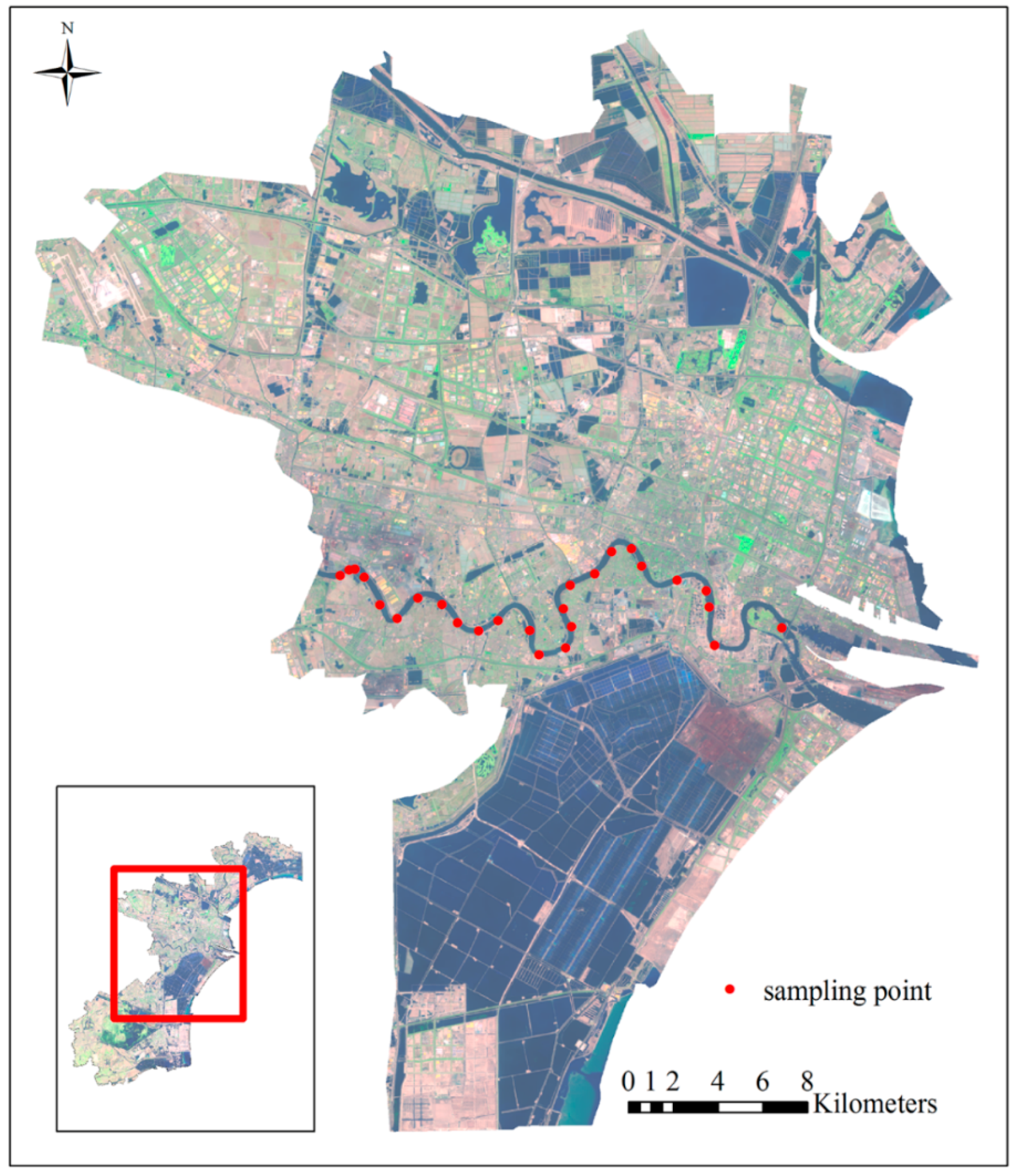
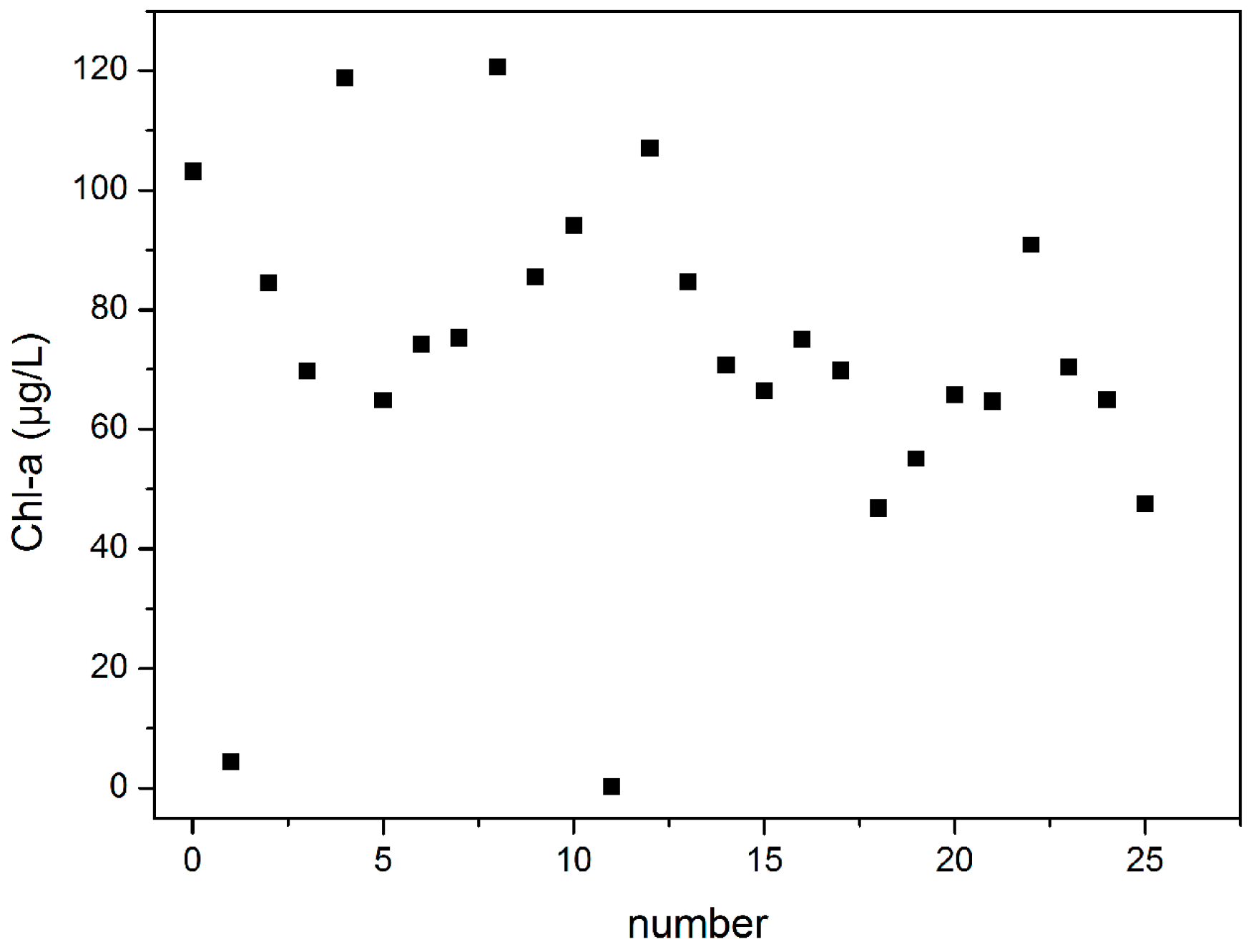
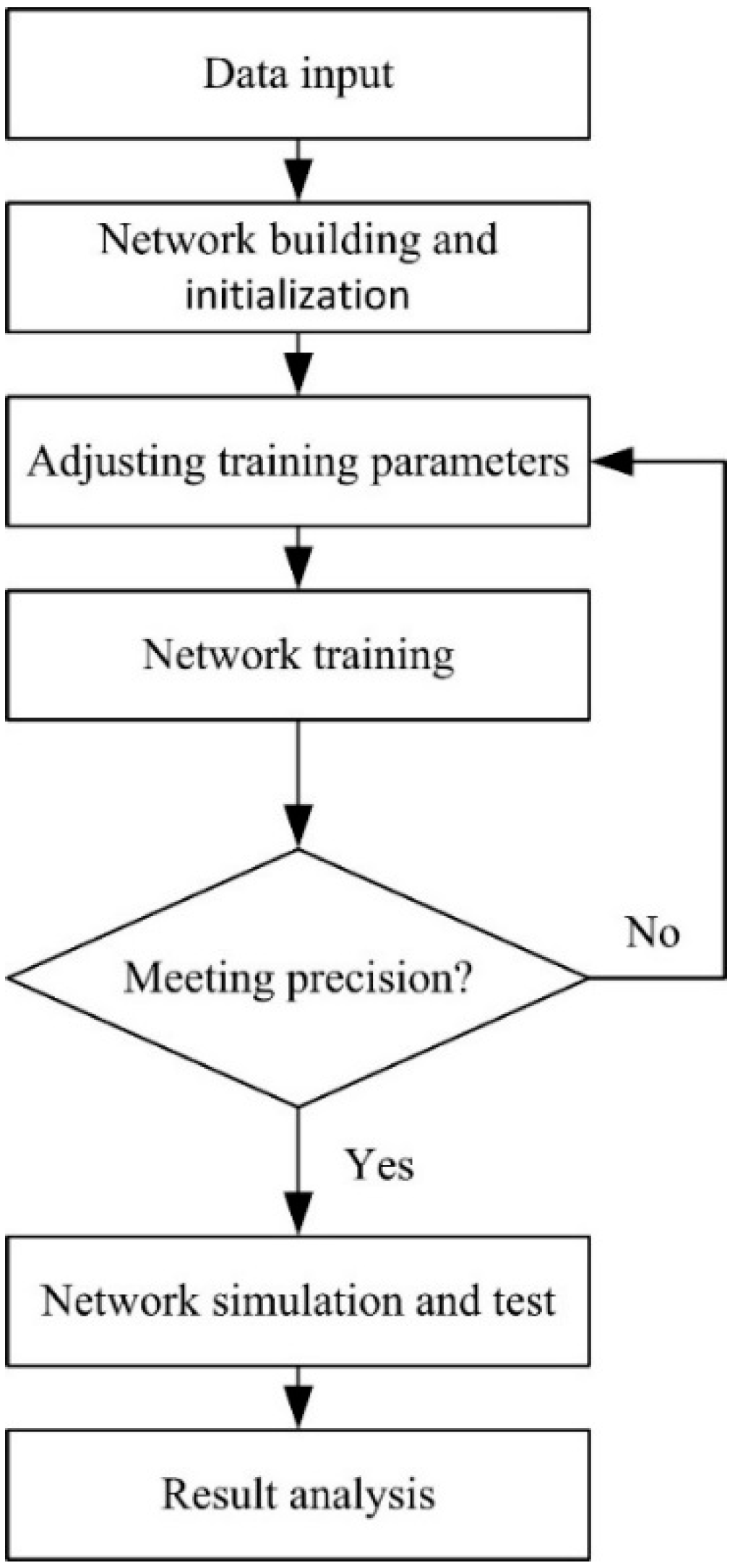

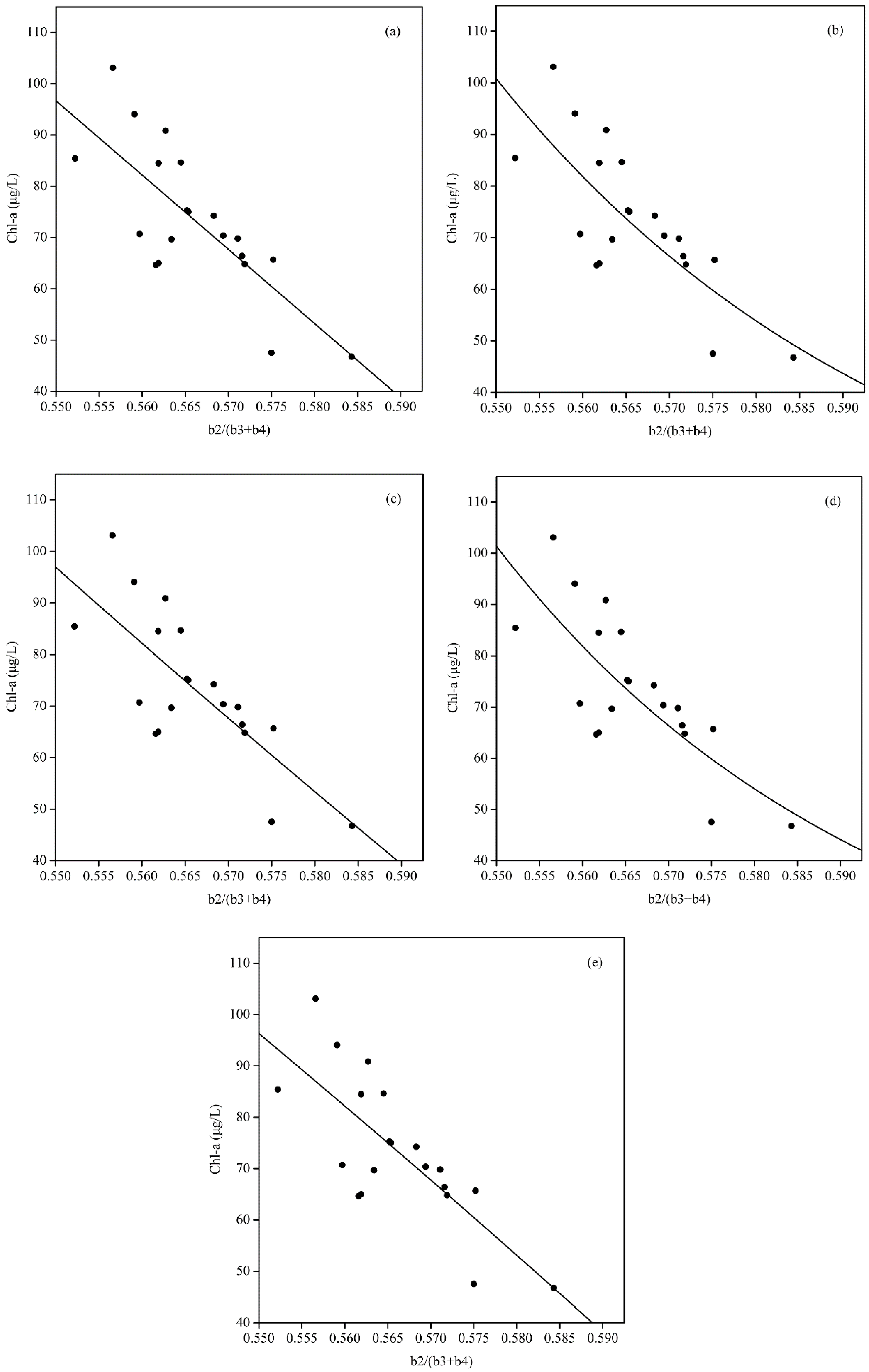

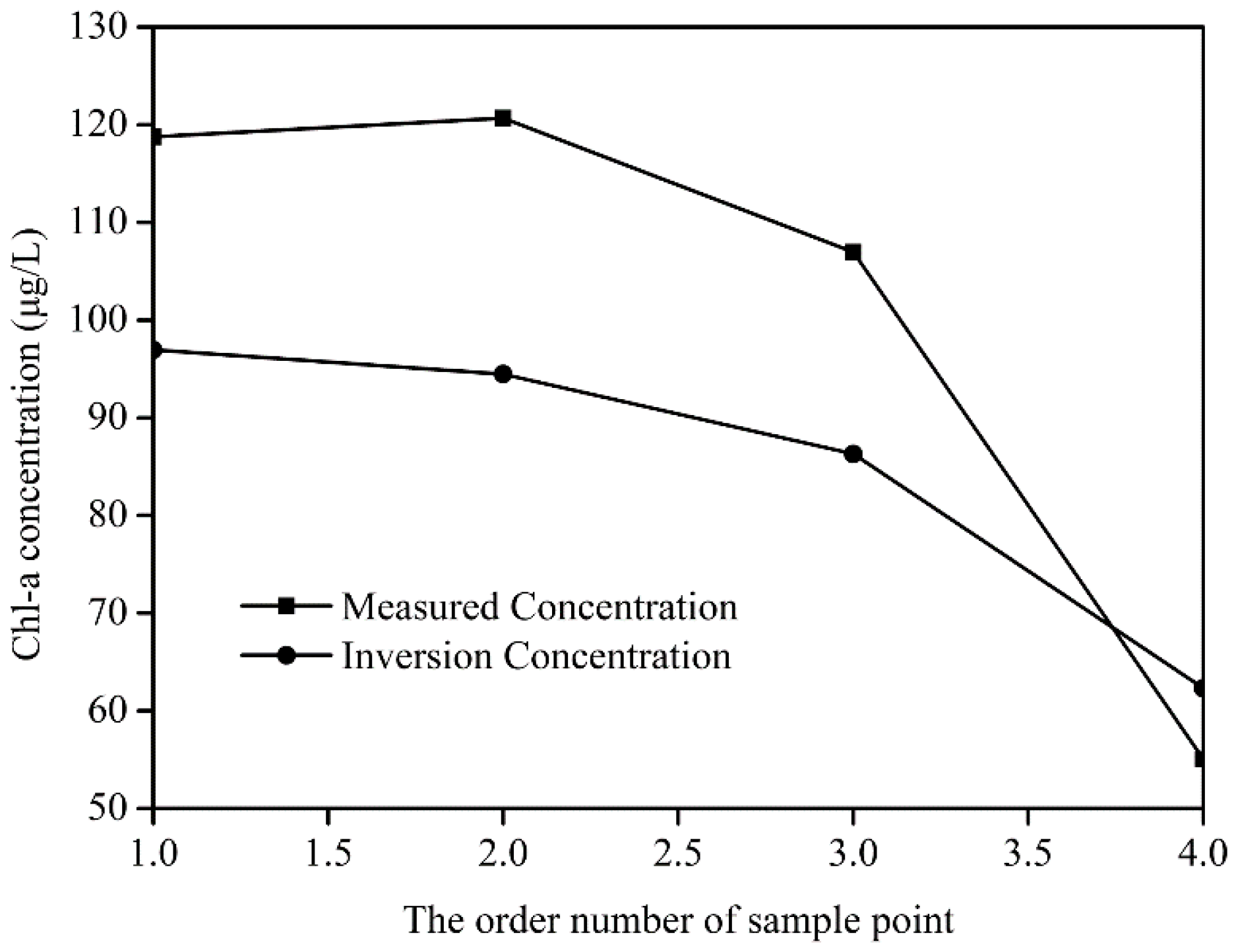
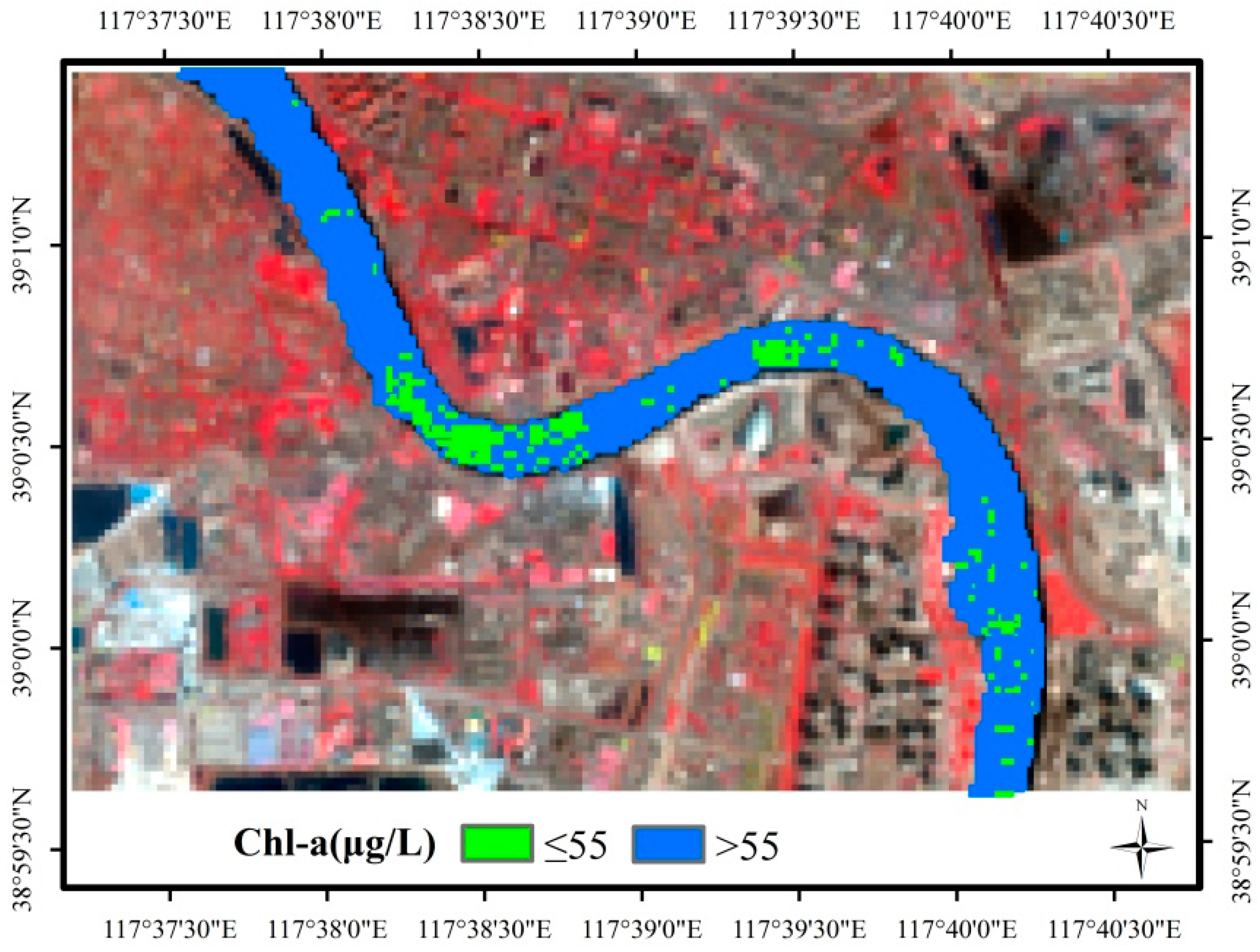
| Mathematic Model | Fitted Equation | R-Square |
|---|---|---|
| Linearity | y = −1446.933x + 892.461 | 0.583 |
| Exponent | y = 9921252.875e−20.903x | 0.611 |
| Logarithm | y = −820.955 ln(x) − 393.826 | 0.583 |
| Power | y = 0.085x−11.849 | 0.610 |
| Polynomial | y = −1274.687x2 + 481.917 | 0.584 |
| Mathematic Model | SSE | Adjusted R-Square | RMSE |
|---|---|---|---|
| Linearity model | 1569.383 | 0.560 | 9.337 |
| Exponent model | 1631.027 | 0.590 | 9.519 |
| Logarithm model | 1571.965 | 0.559 | 9.345 |
| Power model | 1637.414 | 0.588 | 9.538 |
| Polynomial model | 1567.177 | 0.561 | 9.331 |
| Measured Concentration (μg/L) | 118.76 | 120.66 | 106.95 | 55.05 | |
| Linearity model | Inversion concentration (μg/L) | 78.56 | 80.15 | 73.79 | 69.45 |
| Absolute error (μg/L) | −40.2 | −40.51 | −33.16 | 14.4 | |
| Relative error (%) | −33.85 | −33.57 | −31 | 26.16 | |
| Exponential model | Inversion concentration (μg/L) | 77.65 | 78.57 | 72.48 | 68.07 |
| Absolute error (μg/L) | −41.11 | −42.09 | −34.47 | 13.02 | |
| Relative error (%) | −34.62 | −34.88 | −32.23 | 23.65 | |
| Hidden Layer Nodes Number | 15 | 16 | 17 | 18 | 19 | 20 |
|---|---|---|---|---|---|---|
| MSE | 800.1991 | 559.9822 | 488.8999 | 475.8522 | 460.7343 | 410.1737 |
| R-square | 0.65 | 0.71 | 0.74 | 0.75 | 0.88 | 0.94 |
| Sample Points Number | Measured Concentration (μg/L) | Inversion Concentration (μg/L) | Absolute Error (μg/L) | Relative Error (%) |
|---|---|---|---|---|
| 1 | 118.7556 | 96.9535 | 21.8021 | −18.4 |
| 2 | 120.6582 | 94.4702 | 26.1880 | −21.7 |
| 3 | 106.9526 | 86.2942 | 20.6584 | −19.3 |
| 4 | 55.0544 | 62.3194 | 7.2650 | 13.2 |
© 2016 by the authors; licensee MDPI, Basel, Switzerland. This article is an open access article distributed under the terms and conditions of the Creative Commons Attribution (CC-BY) license (http://creativecommons.org/licenses/by/4.0/).
Share and Cite
Guo, Q.; Wu, X.; Bing, Q.; Pan, Y.; Wang, Z.; Fu, Y.; Wang, D.; Liu, J. Study on Retrieval of Chlorophyll-a Concentration Based on Landsat OLI Imagery in the Haihe River, China. Sustainability 2016, 8, 758. https://doi.org/10.3390/su8080758
Guo Q, Wu X, Bing Q, Pan Y, Wang Z, Fu Y, Wang D, Liu J. Study on Retrieval of Chlorophyll-a Concentration Based on Landsat OLI Imagery in the Haihe River, China. Sustainability. 2016; 8(8):758. https://doi.org/10.3390/su8080758
Chicago/Turabian StyleGuo, Qiaozhen, Xiaoxu Wu, Qixuan Bing, Yingyang Pan, Zhiheng Wang, Ying Fu, Dongchuan Wang, and Jianing Liu. 2016. "Study on Retrieval of Chlorophyll-a Concentration Based on Landsat OLI Imagery in the Haihe River, China" Sustainability 8, no. 8: 758. https://doi.org/10.3390/su8080758






